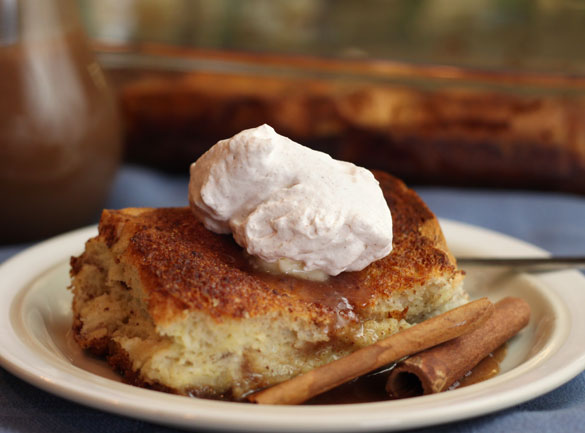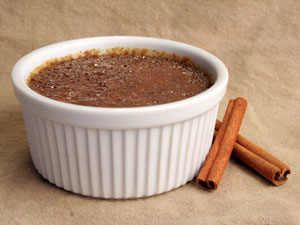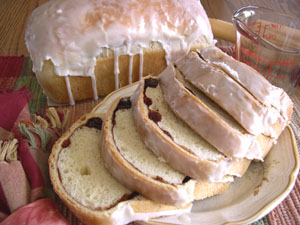 The Secrets of the Pros: How to Transform Your Baking with Cinnamon
The Secrets of the Pros: How to Transform Your Baking with Cinnamon
“Nothing makes such a magical difference in your baking as really good cinnamon. And teaching children the value of aromatic smells and tastes -cooking with kids will do that – even if they don’t want to eat it afterward – at least try it once! That’s our rule. It doesn’t always work but we try!
Cinnamon is America’s favorite spice. It seems to be in almost everything from cookies to cakes to pies. But few recipes really reach the potential cinnamon has to offer. Cinnamon can make a magical difference—with the right cinnamon and use.
The Secrets of the Pros
Secret #1 Use really good cinnamon. Professional chefs use really good cinnamon . . . and there is a world of difference between the good stuff and what you find in many stores.
How do you get the good stuff? Buy it on the internet or from a specialty store. Smell it. Taste it. It should not taste nor smell like a drug store. Put a little on your finger and taste it. It should have some punch and won’t be sweet but it should not be bitter or astringent. If it tastes nasty on your finger, don’t put it in your cookies.
Secret #2 Learn the different flavors of the cinnamons. There are three major varieties of cinnamon: Korintje cassia, Ceylon or Sri Lankan, and Vietnamese or Saigon. They have very different flavors.
Cassia is the cinnamon we are most familiar with and what you’ll buy in the grocery store. And the problematic, poor quality cinnamons are almost always cassia cinnamons. Really good cassia is wonderful.
Ceylon cinnamon is very mild, almost fruity. Vietnamese cinnamon packs a punch and is much more flavorful than cassis with tones of cinnamon oil. It is delightfully fragrant and very distinctive. Vietnamese cinnamon has a very different flavor.
We recommend having all three for your pantry. Choose the cinnamon to fit your taste and the recipe. Ceylon is a delicate flavor and gets lost with a lot of competing flavors but is perfect for a buttery pastry or cinnamon roll. We love Vietnamese in apple pies and other fruit pies and cobblers. It is essential with chocolate.
Secret #3 Don’t be afraid to double-up. If it’s good cinnamon and you want the taste to come through, double or triple the amount of cinnamon that the recipe calls for. In apple pies, we have used as much as four times the cinnamon. In most recipes, when you only use what the recipe calls for, the cinnamon disappears and you can barely taste it. If it’s a poor cinnamon, you don’t want it in your recipe at all but if it’s good, showcase it.
Learn more about each cinnamon Here are some of our favorite recipes that are really set apart by their cinnamon flavor. But don’t take our word for it—try them yourself!
How to Make Cinnamon Crème Brulee
Cinnamon Crème Brulee is one of our favorites. Not only does the cinnamon add a wonderful flavor to the custard, the cinnamon flecks are very attractive. Be sure that you use a top quality cinnamon.
Ingredients 9 large egg yolks 1 teaspoon cinnamon 1/4 teaspoon of salt 1/2 cup granulated sugar 3 cups heavy cream 1 teaspoon vanilla extract 1/2 cup brown sugar
Directions
- To make the custard, mix the egg yolks, cinnamon, salt, and the granulated sugar together until they are combined.
- Heat the cream in a saucepan on medium heat until it just starts to bubble, not boil. Gradually stir in the hot cream into the sugar and egg mixture. Add the vanilla.
- Preheat the oven to 350 degrees.
- Place a folded towel in the bottom of a baking dish. The towel will insulate the custard from heat on the bottom of the pan. Set 4 eight-ounce or 8 four-ounce ramekins on the towel. Divide the custard mixture between the ramekins. Set the baking dish with the ramekins on the shelf of the oven. Carefully pour hot water in the pan—without splashing water into the ramekins—until the water is halfway up the sides of the ramekins. Cover the pan with foil. Bake for 30 to 40 minutes or until the custard is just set.
- Let cool in the pan with the water, then remove the ramekins from the baking dish, cover with plastic wrap and refrigerate for 3 hours or until chilled.
- Use a paper towel to dab up condensation on the tops of the desserts. Sprinkle the tops with an even coating of brown sugar. Place the rack high in the oven and set the oven to the broiler setting. The tops of the ramekins should be close to the broiler.
- Heat for a few minutes under the broiler, just long enough for the brown sugar to caramelize. Serve immediately or return to the refrigerator to chill.
Baker’s Notes: Baking times for the custard vary substantially and depend on the pans used, how hot the water is, and how deep it is. You should bake until the custard is gently set. You want to heat the brown sugar quickly so that it does not heat the custard. Of course, you can use a blow torch. Serve the same day or the caramel topping will become soft. We sometimes place the ramekins in the freezer to chill more quickly. Do not let the custards freeze.
Cinnamon Vanilla Cream Syrup
This is a multi-purpose syrup. It works on your pancakes and it works very well on desserts and ice cream as well.
This syrup is made with Cinnamon Vanilla Sugar. Cinnamon vanilla sugar is made with a mixture of cinnamon, granulated sugar, and dry vanilla.
We use a 50/50 mixture of cinnamon vanilla sugar and sugar in other recipes—just substitute the mixture for the sugar in the recipe.
Ingredients 2 tablespoons cornstarch
1/2 cup cinnamon vanilla sugar 1/2 cup granulated sugar 1 cup cream
1 tablespoon corn syrup 4 tablespoons butter
Directions Mix the cornstarch with the two sugars in a saucepan with a whisk until the cornstarch is well dispersed. Add the cream and corn syrup and heat until bubbly and thick, stirring often. Remove from the heat and stir in the butter.
Frosted Cinnamon Raisin Bread Recipe
This beautiful bread is an attention getter. It is like cinnamon rolls in a loaf. You’ll find this a great snacking bread that will attract kids and neighbors—but try to save several slices for your morning toast.
Ingredients 2 cups water at 105 to 110 degrees 5 cups good quality bread flour 1 7-gram packet instant yeast 4 tablespoons butter, melted and cooled 3 tablespoons granulated sugar 2 teaspoons salt 1/3 cup dry milk powder, preferably high heat treated dry milk 1/4 cup good quality cinnamon 2 tablespoons granulated sugar 4 tablespoons butter 1 cup raisins 3/4 cups walnut pieces, optional For the frosting: 1 1/2 cups powdered sugar 1 tablespoon meringue powder or one egg white 1/2 teaspoon lemon, vanilla, or almond extract milk
Directions Prepare two 9 x 5-inch pans by greasing the inside of the pans, including the rims.
- Carefully measure 2 cups of lukewarm water. Use a kitchen thermometer to determine the water temperature. The water should be slightly warmer than body temperature when you immerse your finger in it.
- Combine approximately 1/3 of the flour, the water, and the yeast by beating with a dough hook for 30 seconds or until combined. Add the remainder of the flour, the melted butter, the 3 tablespoons sugar, salt, and dry milkand continue mixing for at least five minutes at medium speed. The dough should be soft (but not too sticky to handle), smooth, and elastic. Water absorption may vary depending on environmental conditions. If you feel that the dough is too moist, add a little more flour.
- Place the dough in a large greased bowl and turn once to oil all sides. Cover with plastic wrap. Let the dough rise until doubled, about one hour. Turn the dough onto a lightly greased work area. Deflate the dough by gently folding and pressing most of the air from the dough.
- Divide the dough in two with a knife. Roll or press each half into an 8 x 14-inch rectangle.
- Mix the cinnamon and the sugar together. Cut the four tablespoons butter into small chunks and spread the butter pieces on the rolled dough pieces. Spread the cinnamonand sugar mix on the two dough rectangles to within 1/2 inch of the edges and then sprinkle with raisins and optional nuts on the two dough pieces.
- Roll the dough like a jellyroll into an eight-inch wide roll. Roll the dough as tightly as you can gently stretching the surface of the dough. Place seam side down in a loaf pan and repeat with the second loaf. Gently form the dough in the pans to create uniform loaves.
- Cover lightly with plastic wrap and set aside to rise until doubled, about one hour. Rise times will vary with conditions, especially temperature–yeast is very sensitive to temperature.
- While the bread is still rising, preheat the oven to 350 degrees. When the bread has risen, place the loaves on the center rack of the oven leaving as much room for the air to circulate around the loaves as possible. Bake for 35 minutes or until the bread is done and well-browned. If you have a probe-type thermometer, the internal temperature should reach 200 to 210 degrees. If the bread is browning too rapidly, loosely cover with aluminum foil for the last five minutes or so. Immediately remove the loaves from the pans and cool them on a wire rack.
- Frost the bread while still warm but not hot. In a medium bowl, mix the powdered sugar, meringue powder, and extract. Add 2 tablespoons milk. Stir to mix, adding more milk as necessary but not more than one teaspoon at a time. The frosting should be so thick that it will not quite drop from the spoon. When you frost the bread, the heat of the warm bread will soften the frosting further and allow it to flow slightly. The frosting will set as the bread cools. Slice the bread after it has completely cooled.





